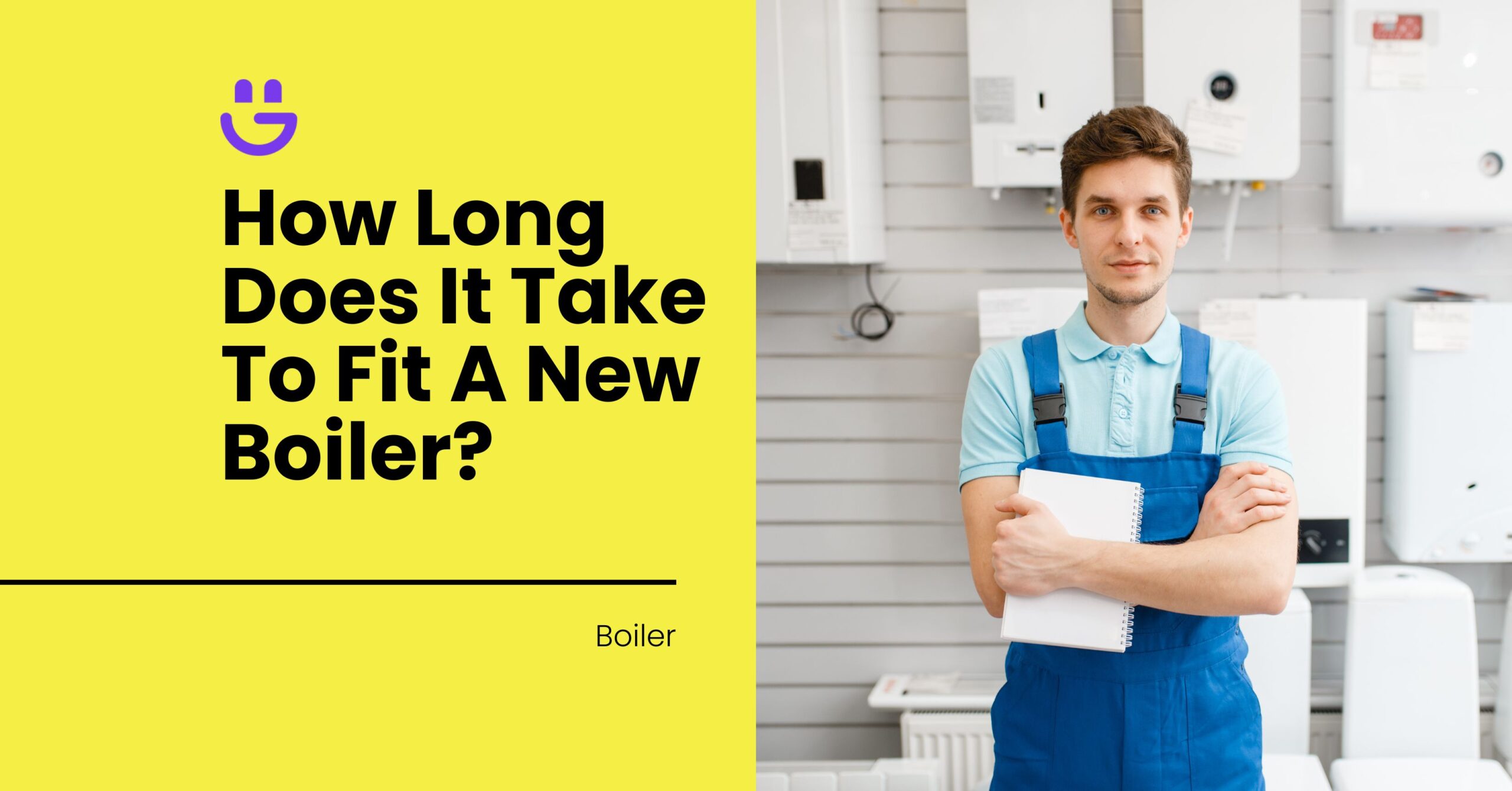Last Updated on November 14, 2025
When replacing or upgrading a boiler, time is often a crucial factor for homeowners and landlords. You want to know how long you’ll be without heating and hot water, and whether there are ways to speed up the process.
In this guide, we’ll break down the key factors affecting installation time, the step-by-step process, and tips for a smooth installation.
Contents
- 1 What Affects Boiler Installation Time?
- 2 Step-by-Step Boiler Installation Process
- 3 How to Speed Up the Boiler Installation Process
- 3.1 1. Choose a Like-for-Like Replacement
- 3.2 2. Ensure Clear Access to the Installation Area
- 3.3 3. Book a Gas Safe Registered Engineer
- 3.4 4. Discuss Additional Work in Advance
- 3.5 5. Check Your Gas Supply & Pressure
- 3.6 6. Schedule Your Installation During Off-Peak Seasons
- 3.7 7. Have a Backup Heating Plan (For Longer Installations)
- 4 Thinking About a New Boiler?
- 5 FAQs
- 5.1 How long does it take to remove and install a new boiler?
- 5.2 Is fitting a new boiler messy?
- 5.3 Do you need access to all radiators when fitting a new boiler?
- 5.4 Do you need to change the pipework for a new boiler?
- 5.5 Does the water get turned off when fitting a new boiler?
- 5.6 Does a new boiler increase house price?
- 6 Final Thoughts
What Affects Boiler Installation Time?
Several factors influence how long it takes to fit a new boiler. The complexity of the installation, the condition of your current system, and additional work required all play a role.
1. Type of Boiler Installation
The type of boiler you’re installing and whether you’re replacing an old system like-for-like or making an upgrade significantly impact the time required.
Like-for-Like Replacement (Combi to Combi) – 4–6 hours
If you’re replacing a combi boiler with another combi boiler in the same location, this is the fastest type of installation. Since combi boilers don’t require separate water tanks or cylinders, the engineer only needs to:
✔ Remove the old boiler
✔ Install the new boiler on the existing pipework
✔ Connect it to the gas and water supply
✔ Run safety checks and commission the system
This process is usually completed in a single day, assuming the existing pipework is in good condition.
System Upgrade (e.g., System to Combi) – 1–2 days
Upgrading from a system boiler to a combi boiler takes longer because:
- The hot water cylinder and cold water storage tank need to be removed.
- The engineer must reroute the pipework.
- A combi boiler requires a larger gas supply pipe (often 22mm rather than 15mm), so new pipework may be needed.
Depending on the complexity, this type of installation takes 1 to 2 days.
Full Central Heating System Installation – 3–5 days
If your property doesn’t have an existing gas boiler or you’re switching from electric or oil heating, the installation will be more complex. This includes:
- Installing a brand-new boiler, radiators, and pipework
- Running new gas, water, and heating pipes throughout the house
- Installing a flue system and ensuring proper ventilation
Because this is a complete system fit-out, it can take 3 to 5 days depending on the size of the property and any unforeseen complications.
2. Condition of Existing Pipework & Infrastructure
Even if you’re replacing a boiler with the same type, the condition of the pipework can affect how long the installation takes.
✔ If the existing gas and water pipes are in good condition → The process is straightforward.
✖ If pipes are corroded, leaking, or undersized → The engineer will need to replace them, adding extra time.
Gas Safe regulations also require that the gas supply pipe meets the correct size for the new boiler. If upgrading to a higher-output combi boiler, a larger gas pipe (22mm or even 28mm) may be required. This means running new pipework from the gas meter, which could take several extra hours or even an additional day.
3. Boiler Location
Where your boiler is installed also impacts how long the job takes.
✔ Keeping the boiler in the same location → Faster installation, as no additional pipework needs to be run.
✖ Moving the boiler to a new location → Extra time required for:
- Running new gas and water pipes
- Extending or relocating the flue (which may require external wall modifications)
- Adjusting electrical connections and thermostats
Moving a boiler within the same room may only add a few hours, but moving it to another floor or further away from the gas meter could extend the installation to 2 days or more.
4. Additional Work Requirements
Certain upgrades and additional tasks can add to the total installation time:
| Task | Additional Time Required | Reason |
|---|---|---|
| Power Flushing | 2–4 hours | Cleans out sludge from radiators and pipes to improve efficiency. |
| Smart Thermostat Installation | 1–2 hours | Requires new wiring and Wi-Fi setup. |
| Magnetic Filter Installation | 1 hour | Protects the boiler from sludge buildup. |
| New Radiators | 1–2 hours per radiator | Replacing multiple radiators can add a full day. |
While these add-ons improve efficiency and prolong the lifespan of your boiler, they can extend installation time.
Step-by-Step Boiler Installation Process
1. Initial Assessment
📌 The engineer arrives and inspects the existing system.
📌 Homeowner or landlord discusses preferences (e.g., smart thermostats, filter installation).
📌 Engineer confirms boiler type, location, and any upgrades required.
2. Preparation & Removal of Old Boiler (1–2 hours)
📌 Power and water supplies are turned off.
📌 Old boiler is disconnected from the gas, water, and heating system.
📌 If needed, the old flue is removed and replaced.
📌 Any redundant tanks (if upgrading from a conventional boiler to a combi) are removed.
3. Installation of New Boiler & Pipework (2–6 hours)
📌 New boiler is positioned and secured.
📌 Gas, water, and heating pipes are connected.
📌 The flue is installed and positioned correctly for ventilation.
📌 If required, gas pipe upgrades are carried out.
📌 System is pressure-tested to check for leaks.
4. System Testing & Safety Checks (1–2 hours)
📌 Engineer fills the system with water and checks for leaks.
📌 Boiler is turned on and tested at different heating settings.
📌 Carbon monoxide and flue gas analysis is performed for safety.
📌 Gas Safe compliance checks are carried out.
5. Handover & User Demonstration (30–60 minutes)
📌 The engineer explains how to operate the boiler.
📌 Thermostat and programmer settings are demonstrated.
📌 Gas Safe certificate and warranty documents are provided.
📌 The homeowner or landlord can ask any final questions.
How to Speed Up the Boiler Installation Process
A boiler installation can take anywhere from a few hours to several days, depending on the complexity of the job. However, as a homeowner or landlord, there are several steps you can take to speed up the process while ensuring a smooth and hassle-free installation. Here’s how:
1. Choose a Like-for-Like Replacement
Why this helps:
Replacing your existing boiler with the same type (e.g., combi-to-combi, system-to-system) significantly reduces installation time. This is because the pipework, flue positioning, and controls are already set up for that type of boiler.
✅ What this means for you:
- Minimal disruption, as the engineer won’t need to reroute pipework or upgrade the gas supply.
- The boiler can be installed and tested within a single day.
2. Ensure Clear Access to the Installation Area
Why this helps:
Boiler installations involve heavy lifting, pipework modifications, and access to gas and water connections. A cluttered work area can slow down the process and create safety hazards.
✅ What you can do:
- Clear the space around the boiler – Move any furniture, cleaning supplies, or storage items.
- Ensure loft or airing cupboard access (for system or conventional boilers).
- Keep outdoor areas clear if the engineer needs to install or adjust the flue.
Bonus Tip: If the engineer needs to access other parts of the home (e.g., airing cupboard, gas meter, or radiator pipes), ensure these areas are also clear.
3. Book a Gas Safe Registered Engineer
Why this helps:
Only a Gas Safe registered engineer is legally allowed to install a gas boiler in the UK. Hiring a professional ensures the job is done efficiently, safely, and in compliance with building regulations.
✅ What to check:
- Ask for the engineer’s Gas Safe ID card (or check their details on the Gas Safe Register).
- Read online reviews and check their experience with your type of boiler.
- Ensure they provide a Gas Safe certificate upon completion of the job.
Avoid DIY installations or unqualified engineers – not only is this illegal, but it can also lead to dangerous gas leaks and void your boiler’s warranty.
4. Discuss Additional Work in Advance
Why this helps:
Many homeowners decide to add smart thermostats, magnetic filters, or power flushing during a boiler installation. While these are great upgrades, they require extra time and planning.
✅ What you can do:
- Decide in advance if you want a smart thermostat (e.g., Hive or Nest), as this may require additional wiring and setup.
- Consider a magnetic filter – This prevents sludge buildup in the system, helping your boiler run efficiently for longer.
- Ask about a power flush if you have old radiators or suspect sludge buildup.
If additional work is not planned ahead:
The engineer may need to return another day to complete these tasks, delaying full completion of the job.
5. Check Your Gas Supply & Pressure
Why this helps:
Some newer, high-efficiency boilers require a larger gas supply pipe (usually 22mm or 28mm). If your home has an older 15mm pipe, the engineer will need to upgrade it, adding several extra hours to the job.
✅ What you can do:
- Ask your installer to assess your gas supply in advance.
- If a gas pipe upgrade is needed, schedule it before the installation date to avoid delays.
6. Schedule Your Installation During Off-Peak Seasons
Why this helps:
Winter is the busiest time for boiler engineers due to emergency breakdowns. Booking your installation in spring or summer can mean:
- Quicker availability of engineers.
- Less pressure on installers, allowing for a smoother and more thorough job.
- Better deals or promotions on new boilers.
✅ What you can do:
- If your boiler is old or unreliable, don’t wait for it to fail in winter – plan ahead!
- Book well in advance if you’re a landlord, so tenants aren’t left without heating in peak season.
7. Have a Backup Heating Plan (For Longer Installations)
Why this helps:
If your installation takes more than a day, you may be without heating or hot water. This is especially important for families, elderly residents, or rental properties.
✅ What you can do:
- Use electric heaters in main living areas.
- Boil water for washing dishes and personal hygiene.
- If necessary, arrange for tenants or residents to stay elsewhere overnight.
Thinking About a New Boiler?
At Eco Happy, we make the process quick, simple, and hassle-free. Just answer a few quick questions about your home, and our team will provide you with a free, no-obligation quote within minutes!
✅ Fast & Easy – No lengthy forms, just a few simple questions.
✅ Expert Advice – Get recommendations from Gas Safe engineers.
✅ Competitive Prices – High-quality boilers at great prices.
Don’t wait, get your FREE boiler quote today!
FAQs
How long does it take to remove and install a new boiler?
4–6 hours
A straightforward boiler replacement takes 4–6 hours, involving system isolation, draining, disconnection, and installation. Upgrading to a different boiler type or relocating it may extend the process to 1–3 days.
Is fitting a new boiler messy?
Boiler installation can be minimally messy, but professional engineers take steps to keep disruption low. A like-for-like replacement is usually clean and straightforward, while system upgrades or relocations may involve drilling and pipework adjustments, creating some dust and debris. Most installers use dust sheets and tidy up after completion.
Do you need access to all radiators when fitting a new boiler?
In most cases, yes. Engineers may need access to all radiators to flush the system, check for leaks, and ensure proper balancing. If pipework changes are required, additional access may be needed.
Do you need to change the pipework for a new boiler?
No. If replacing a boiler like-for-like, the existing pipework is usually compatible. However, upgrades (e.g., system to combi boiler) or relocations often require new pipework to meet modern efficiency and safety standards. A Gas Safe engineer will assess your setup and make necessary adjustments.
Does the water get turned off when fitting a new boiler?
Yes, the water supply is temporarily turned off during boiler installation to drain the system and connect the new unit. In most cases, water is restored the same day once the installation is complete.
Does a new boiler increase house price?
Yes, installing a new boiler can increase your home’s value by improving energy efficiency, reducing running costs, and making the property more attractive to buyers. A modern, energy-efficient boiler can also boost your EPC rating, which is a key factor for potential buyers.
Final Thoughts
A simple combi boiler swap can be done in a day, while a full system installation can take up to a week. Factors such as boiler type, pipework condition, location, and additional work all impact installation time.
To ensure a smooth process, hire a Gas Safe registered engineer who can assess your home’s heating needs and provide expert installation.






Tom Allen
Solar Expert